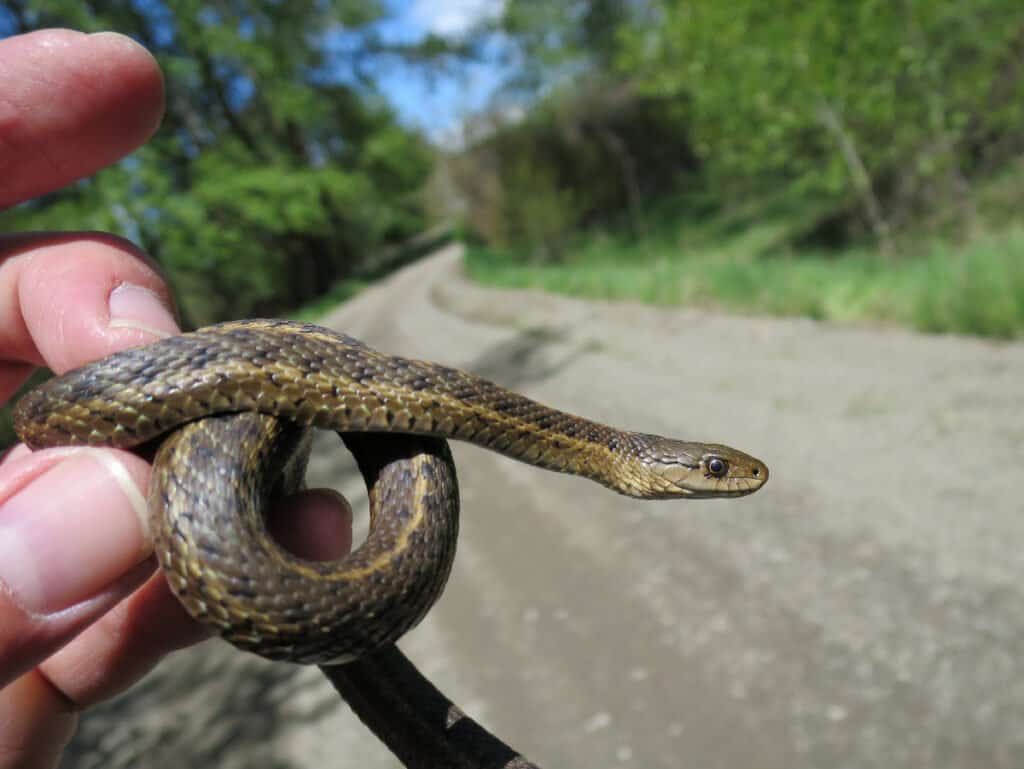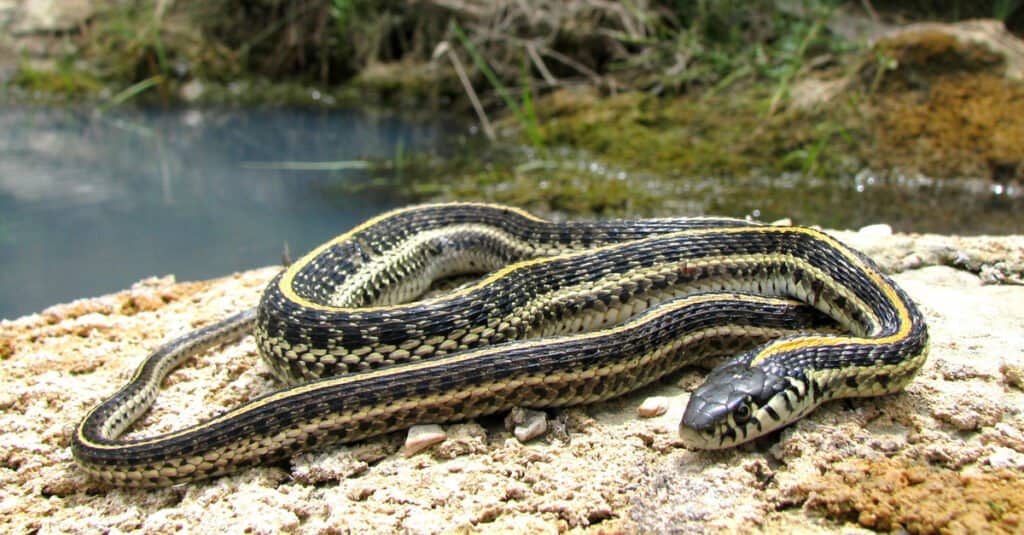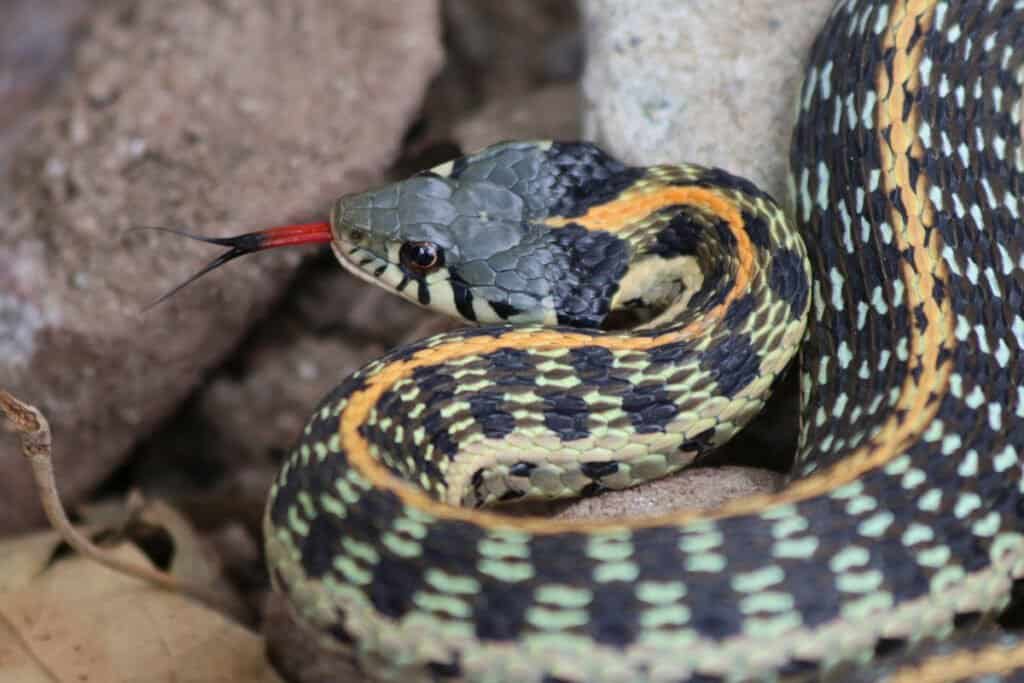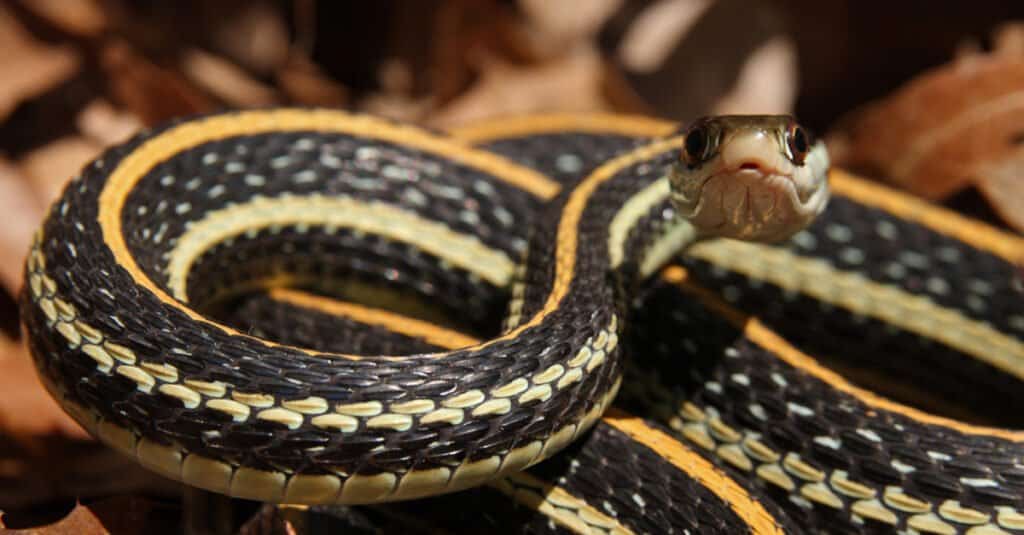Colorado is well known for the towering peaks of the Rocky Mountains that run through the state, but it’s a land of diverse geography. It’s part of the western and southwestern United States and is made up of mountains, forests, plains and plateaus, deep canyons, rivers, and deserts. This varied landscape is home to an abundance of animals. Wildlife in Colorado ranges from bison, bighorn sheep, and bears to deer, foxes, and squirrels. Many snakes find their home here as well. In fact, there are approximately 30 snake species in Colorado, including garter snakes. Let’s take a look at garter snakes in Colorado and find out which species live there.
Get Familiar with the Garter Snake
Garter snakes eat insects, slugs, rodents, and other small prey, so they can be a welcome garden companion. They help to keep common pests at bay and prefer to stay mostly out of sight. Although their saliva is toxic to their prey, they don’t have venom that’s harmful to humans. The garter snake sometimes called a grass snake, is part of the Natricinnae subfamily. Like most in this group, they are ovoviviparous and give birth to live young. Their genus Thamnophis includes about 35 garter snake species. The name is derived from the Greek words thamnos, meaning ‘bush or shrub’, and ophio, which means ‘snake.’
Like all snakes, garter snakes are ectotherms, meaning that they regulate their body temperature by either absorbing or giving off heat. Since their temperature is entirely dependent on environmental conditions, you might find garter snakes in the shade during the heat of the day, or sunning themselves on rocks when they need to warm up. They’re often attracted to the heat that radiates from paved roads. Native to North America, the common garter snake species name is Thamnophis sirtalis. Sirtalis is Latin for “like a garter.” It likely refers to their similarity in appearance to old-fashioned sock garters. Let’s find out if you can find the common garter snake in Colorado and what other species might be spotted there.
Garter Snakes in Colorado

Garter snakes in Colorado tend to live near lakes, rivers, streams, and marshes.
©iStock.com/Gerald Zaffuts
You can find garter snakes in forested areas, open fields, grasslands, wetland borders, and marshes. They tend to live near water bodies like lakes and streams. While you’re most likely to find them in your backyard in the summertime, they often show up in basements in autumn. Garter snakes go into a period of inactivity called brumation during the cold winter months. They usually brumate in crevices under rocks, in trees, or on the banks of streams. As they seek out their site to bed down through the weather’s cold, they’ll sometimes find their way into buildings and it can be hard for them to find their way back out. Garter snakes find themselves among venomous rattlesnakes in Colorado, as well as harmless bullsnakes, yellow-bellied racers, ground snakes, rat snakes, coachwhips, and many other species.
Which Garter Snake Species live in Colorado?
Colorado is home to five species of garter snake. These snakes are all part of the genus Thamnophis, but each species differs in appearance and range. They sometimes prefer slightly different habitats and prey. The species that can be found in Colorado are the common garter snake, the western terrestrial garter snake, the plains garter snake, the black-necked garter snake, and the western ribbon snake.
Common Garter Snake (Thamnophis sirtalis)

The red-sided garter snake is a subspecies of the common garter found in Colorado.
©Matt Jeppson/Shutterstock.com
The common garter snake lives in woods, fields, and brush. It is most common in flood plains and near streams in northern Colorado. While the sight of a snake may catch you by surprise, there’s no reason to fear this snake. If picked up, it may secret a musk as a deterrent or even bite, but its bite isn’t harmful to humans. It can grow to be 16 to 42 inches in length with a thin body. The red-sided garter snake (Thamnophis sirtalis parietalis) is a subspecies of the common garter that lives in Colorado. It’s normally dark green to black in body color with three yellow stripes running the length of its body. Between the stripes are orange or red bars that give this subspecies its name.
Western Terrestrial Garter Snake (Thamnophis elegans)

Unique in its tendency to constrict its prey, the western terrestrial garter is widespread throughout the state.
©Randy Bjorklund/Shutterstock.com
The western terrestrial garter snake lives all over Colorado, except for the Northeast corner of the state. It’s similar to the common garter snake in appearance. It grows to a body length of 16 to 43 inches. It also has three yellow stripes running the length of its body but has a series of black spots between or on the stripes. The background body color of these snakes is brown or greenish. Sometimes you might see an all-black western terrestrial garter snake. Dark brown or black blotches cover their belly.
Like all garter snakes, this species has saliva that contains venom that’s mildly toxic to subdue its prey for easier ingestion. However, this type of garter snake is unique in its tendency to constrict its prey. It’s the only garter snake species that engages in constriction to feed. A study in the Journal of Herpetology found that they were inefficient constrictors in comparison to gopher snakes, but nearly always killed the mice they constricted prior to eating them. The wandering garter snake (Thamnophis elegans vagrans) is a subspecies of the western terrestrial garter that lives in Colorado.
Plains Garter Snake (Thamnophis radix)

Plains garters live in the eastern part of the state.
©Joe Farah/Shutterstock.com
You can find plains garter snakes in eastern Colorado and along the Front Range, the easternmost section of the southern Rocky Mountains. They live near permanent or semi-permanent sources of water. Similar to other species found in this state, plains garter snakes grow to be 16 to 42 inches in length. They have olive green, brown, or black bodies with an orange or yellow dorsal stripe down the back. They also have two greenish-yellow stripes on each side of their body. Plains garters have unique black bars around their mouth. Although no garter snakes pose a threat to humans, this species is particularly docile and is less likely than the common garter snake to bite when handled.
Black-necked Garter Snake (Thamnophis cyrtopsis)

The black-necked garter snake is named for the black blotches behind its jaws.
©Creeping Things/Shutterstock.com
The black-necked garter snakes live in the southeastern and southwestern portions of Colorado. They like to live near permanent sources of water. They can also be found near intermittent streams and may wander to open grasslands, especially near arroyos or temporary pools. Named for the black blotches behind its jaws, the black-necked garter is dark olive in color with a yellow to orange dorsal stripe and cream or gray belly. It can grow to be 16 to 28 inches long on average, but up to 42 inches long.
Western Ribbon Snake (Thamnophis proximus)

The western ribbon snake is a garter that’s found only in a small portion of Colorado.
©Ryan M. Bolton/Shutterstock.com
The western ribbon snakes live only in a small region of northeastern Colorado. They are black, brown, or olive in color with three light-colored stripes down their bodies. They have white bellies that are sometimes greenish or yellowish. These garters are almost always found near water. They live near ponds, marshes, rivers, and lakes. These are fast snakes, but if they are caught they’re more likely to thrash about and expel musk than they are to bite. They have strong jaws to overpower their prey of fish, frogs, toads, salamanders, and earthworms.
The photo featured at the top of this post is © Simone O/Shutterstock.com
Discover the "Monster" Snake 5X Bigger than an Anaconda
Every day A-Z Animals sends out some of the most incredible facts in the world from our free newsletter. Want to discover the 10 most beautiful snakes in the world, a "snake island" where you're never more than 3 feet from danger, or a "monster" snake 5X larger than an anaconda? Then sign up right now and you'll start receiving our daily newsletter absolutely free.
Thank you for reading! Have some feedback for us? Contact the AZ Animals editorial team.






